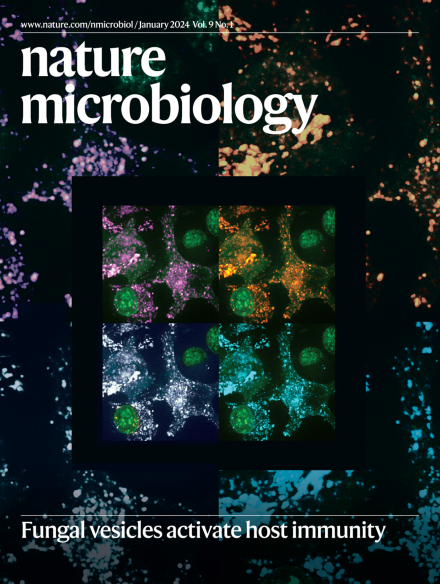结核分枝杆菌衍生的亚油酸增加调节性T细胞功能,促进巨噬细胞内细菌的存活。
IF 19.4
1区 生物学
Q1 MICROBIOLOGY
引用次数: 0
摘要
调节性T (Treg)细胞在结核分枝杆菌(Mtb)感染期间扩增并抑制T细胞介导的控制。结核分枝杆菌是否积极参与这一过程尚不清楚。本研究利用全基因组突变文库,研究人员发现Mtb Rv1272c(一种atp结合盒转运体)的表达在缺氧条件下增加,并通过增加卵磷脂的输入,随后产生和释放亚油酸来促进Mtb在体内的存活。感染巨噬细胞释放的亚油酸通过Ca 2 +转运体ATP2a3促进Treg细胞中免疫检查点分子细胞毒性T淋巴细胞抗原4 (CTLA-4)的表面运输。这反过来抑制巨噬细胞活性氧的产生,促进巨噬细胞内结核分枝杆菌的存活。rv1272c诱导的亚油酸进一步通过增加CTLA-4在Treg细胞上的表面转运来促进Mtb免疫逃逸。在机制上,亚油酸与Treg细胞中的ATP2a3相互作用并促进线粒体相关内质网(ER)膜的形成。这促进了内质网到线粒体的Ca2+转移和内质网中Ca2+的消耗,并触发储存操作的钙进入,从而提高细胞质Ca2+水平,增加Treg细胞中Ca2+依赖的CTLA-4表面运输。这些发现表明Mtb可以利用代谢物操纵宿主反应并促进其细胞内存活。本文章由计算机程序翻译,如有差异,请以英文原文为准。
Mycobacterium tuberculosis-derived linoleic acid increases regulatory T cell function to promote bacterial survival within macrophages.
Regulatory T (Treg) cells expand during Mycobacterium tuberculosis (Mtb) infection and suppress T cell-mediated control. Whether Mtb actively contributes to this process is unclear. Here, using a genome-wide mutant library, we show that the expression of Mtb Rv1272c, an ATP-binding cassette transporter, increased under hypoxic conditions and promotes Mtb survival in vivo by increasing lecithin import, followed by the production and release of linoleic acid. Linoleic acid released by infected macrophages promoted surface trafficking of the immune checkpoint molecule cytotoxic T lymphocyte antigen 4 (CTLA-4) in Treg cells via the Ca²⁺ transporter ATP2a3. This in turn inhibited macrophage reactive oxygen species production and promoted Mtb survival inside macrophages. Rv1272c-induced linoleic acid further promoted Mtb immune evasion by increasing CTLA-4 surface trafficking on Treg cells in vivo. Mechanistically, linoleic acid interacts with ATP2a3 in Treg cells and promotes mitochondria-associated endoplasmic reticulum (ER) membrane formation. This facilitates ER-to-mitochondria Ca2+ transfer and depletion of Ca2+ in the ER, and triggers store-operated calcium entry, thus elevating cytosolic Ca2+ levels to increase Ca2+-dependent CTLA-4 surface trafficking in Treg cells. These findings reveal that Mtb can use a metabolite to manipulate host responses and promote its intracellular survival.
求助全文
通过发布文献求助,成功后即可免费获取论文全文。
去求助
来源期刊

Nature Microbiology
Immunology and Microbiology-Microbiology
CiteScore
44.40
自引率
1.10%
发文量
226
期刊介绍:
Nature Microbiology aims to cover a comprehensive range of topics related to microorganisms. This includes:
Evolution: The journal is interested in exploring the evolutionary aspects of microorganisms. This may include research on their genetic diversity, adaptation, and speciation over time.
Physiology and cell biology: Nature Microbiology seeks to understand the functions and characteristics of microorganisms at the cellular and physiological levels. This may involve studying their metabolism, growth patterns, and cellular processes.
Interactions: The journal focuses on the interactions microorganisms have with each other, as well as their interactions with hosts or the environment. This encompasses investigations into microbial communities, symbiotic relationships, and microbial responses to different environments.
Societal significance: Nature Microbiology recognizes the societal impact of microorganisms and welcomes studies that explore their practical applications. This may include research on microbial diseases, biotechnology, or environmental remediation.
In summary, Nature Microbiology is interested in research related to the evolution, physiology and cell biology of microorganisms, their interactions, and their societal relevance.
 求助内容:
求助内容: 应助结果提醒方式:
应助结果提醒方式:


